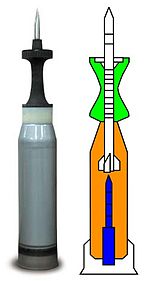Electrothermal-chemical (ETC) technology is an attempt to increase accuracy and muzzle energy of future tank, artillery, and close-in weapon system guns by improving the predictability and rate of expansion of propellants inside the barrel.

A kinetic energy penetrator (KEP), also known as long-rod penetrator (LRP), is a type of ammunition designed to penetrate vehicle armour using a flechette-like, high-sectional density projectile. Like a bullet or kinetic energy weapon, this type of ammunition does not contain explosive payloads and uses purely kinetic energy to penetrate the target. Modern KEP munitions are typically of the armour-piercing fin-stabilized discarding sabot (APFSDS) type.

A sabot is a supportive device used in firearm/artillery ammunitions to fit/patch around a projectile, such as a bullet/slug or a flechette-like projectile, and keep it aligned in the center of the barrel when fired. It allows a narrower projectile with high sectional density to be fired through a barrel of much larger bore diameter with maximal accelerative transfer of kinetic energy. After leaving the muzzle, the sabot typically separates from the projectile in flight, diverting only a very small portion of the overall kinetic energy.
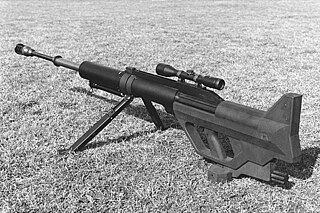
The Steyr IWS 2000 is an Austrian single-shot bolt-action anti-materiel rifle produced by Steyr Mannlicher. IWS stands for Infantry Weapon System. Unlike other anti-tank rifle designs, it has a smoothbore barrel. This facilitates higher projectile velocities and allows a longer barrel service life, but the lack of gyroscopic spin-stabilization requires the projectile to have aerodynamic stabilizing fins instead. The IWS is chambered in a 15.2×169 mm armor-piercing fin-stabilized discarding-sabot cartridge, and is the first man-portable rifle to use this type of ammunition.

Armour-piercing discarding sabot (APDS) is a type of spin-stabilized kinetic energy projectile for anti-armour warfare. Each projectile consists of a sub-calibre round fitted with a sabot. The combination of a lighter sub-calibre projectile with a full-calibre propellant charge allows for an increase in muzzle velocity compared to full-calibre rounds, giving the round increased armour-penetration performance. To further enhance their armour-penetration capabilities, APDS rounds typically feature a hardened core made from tungsten or another hard, dense material.

The CN-105-57, also known as CN 105/57 or D1504, is a light French 105 mm tank gun.
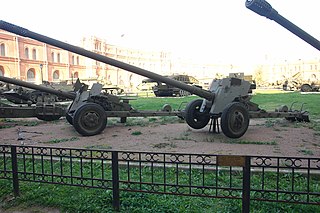
2A19 or T-12 is a Soviet-designed 100-mm anti-tank gun. It was the first anti-tank gun to adopt a smoothbore barrel, and to introduce modern armor piercing shot, like the APFSDS. It uses long projectiles that are more powerful than its caliber suggests. The T-12 served as the primary towed anti-tank artillery in the Soviet and Bulgarian armies from the early 1960s to the late 1980s.
The following is a list of ammunition fired by the 125 mm smoothbore gun series used in the T-64, T-72, T-80, M-84, T-90, PT-91, T-14 Armata, and other tanks derived from those designs, as well as the 2A45 Sprut anti-tank gun.
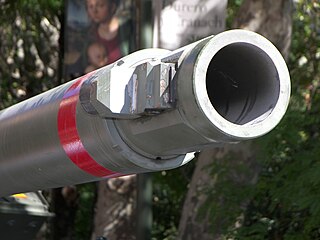
The Rheinmetall Rh-120 is a 120 mm smoothbore tank gun designed and produced in former West Germany by the Rheinmetall-DeTec AG company, it was developed in response to Soviet advances in armour technology and development of new armoured threats. Production began in 1974, with the first version of the gun, known as the L/44 as it was 44 calibres long, used on the German Leopard 2 tank and soon produced under license for the American M1A1 Abrams and other tanks. The 120-millimetre (4.7 in) gun has a length of 5.28 metres (17.3 ft), and the gun system weighs approximately 3,317 kilograms (7,313 lb).

The 14.5×114mm is a heavy machine gun and anti-materiel rifle cartridge used by the Soviet Union, the former Warsaw Pact, modern Russia, and other countries.

The 76 mm gun M1 was an American World War II–era tank gun developed by the U.S United States Ordnance Department in 1942 to supplement the 75 mm gun on the basic Medium tank M4. It was also used to arm the M18 Hellcat tank destroyer.
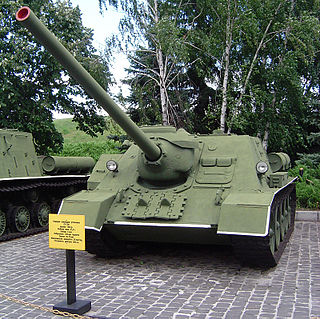
The D-10 is a Soviet 100 mm tank gun developed in late World War II. It originally equipped the SU-100 tank destroyers and was later selected for the T-55 tank, equipping these as late as 1979. On the T-55 the D-10 continues to be in active service in many countries.

Armour-piercing fin-stabilized discarding sabot (APFSDS), long dart penetrator, or simply dart ammunition is a type of kinetic energy penetrator ammunition used to attack modern vehicle armour. As an armament for main battle tanks, it succeeds Armour-Piercing Discarding Sabot (APDS) ammunition, which is still used in small or medium caliber weapon systems.

The L30A1, officially designated Gun, 120 mm, Tank L30,is a British-designed 120 mm rifled tank gun, installed in the turrets of Challenger 2 main battle tanks. It is an improved production model of the Royal Ordnance L11 series of rifled tank guns. Challenger 2 tanks and their L30A1 guns are operated by the British and Omani armies. In 2023, L30A1 armed Challenger 2 tanks supplied by the British were delivered to Ukraine.
The M830 is an American high explosive anti-tank (HEAT) high explosive multi purpose cartridge which has anti-armor and anti-personnel capabilities. This round is meant for the 120 mm M256 main gun of the M1A1 and M1A2 Abrams. The M830 HEAT-MP-T, 120-mm cartridge is a direct translation of the German DM12A1 round with the exception that a United States design fuze system and explosive is used. The propellant system utilizes a metal cartridge case base with a rubber obturator at the stub case mouth, M123A1 Primer, and a combustible wall which encapsulates stick propellant within six containment devices to prevent spillage should breakage or separation occur. The cartridge is black with yellow markings, weighs approximately 53.4 lb, and has a length of 38.6 inches (981 mm). The round was praised for its performance during the 1991 Gulf War. It is no longer manufactured and has been replaced by the M830A1.

The Royal Ordnance L11A5, officially designated Gun, 120 mm, Tank L11, is a 120 mm L/55 rifled tank gun design. It was the second 120 mm calibre tank gun in service with British Army. It was the first of NATO's 120 mm main battle tank guns which became the standard calibre for Western tanks in the later period of the Cold War. A total of 3,012 of the L11 guns were produced by 2005. The list price was US$227,000 in 1990.

120×570mm NATO tank ammunition, also known as 120×570mmR, is a common, NATO-standard, tank gun semi-combustible cartridge used by 120mm smoothbore guns, superseding the earlier 105×617mmR cartridge used in NATO-standard rifled tank guns.

The CN08 is a 120 mm 55-caliber smoothbore gun produced by Hyundai WIA. It is incorrectly known as the licensed production of the Rheinmetall Rh-120 L/55, but it was indigenously developed by the Agency for Defense Development and WIA from 2003 to 2008 for the XK2 development project started in 1995. The development was completed after the field test ended in September 2008.

The M68 is an American 105 mm tank gun. It uses British-designed L7 gun tube and cartridges with an American-designed mount, breech assembly and recoil mechanism.
The KE-W APFSDS round is a type of armor-piercing fin-stabilized discarding sabot (APFSDS) ammunition designed for tank guns.
